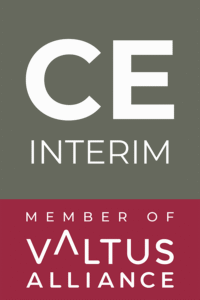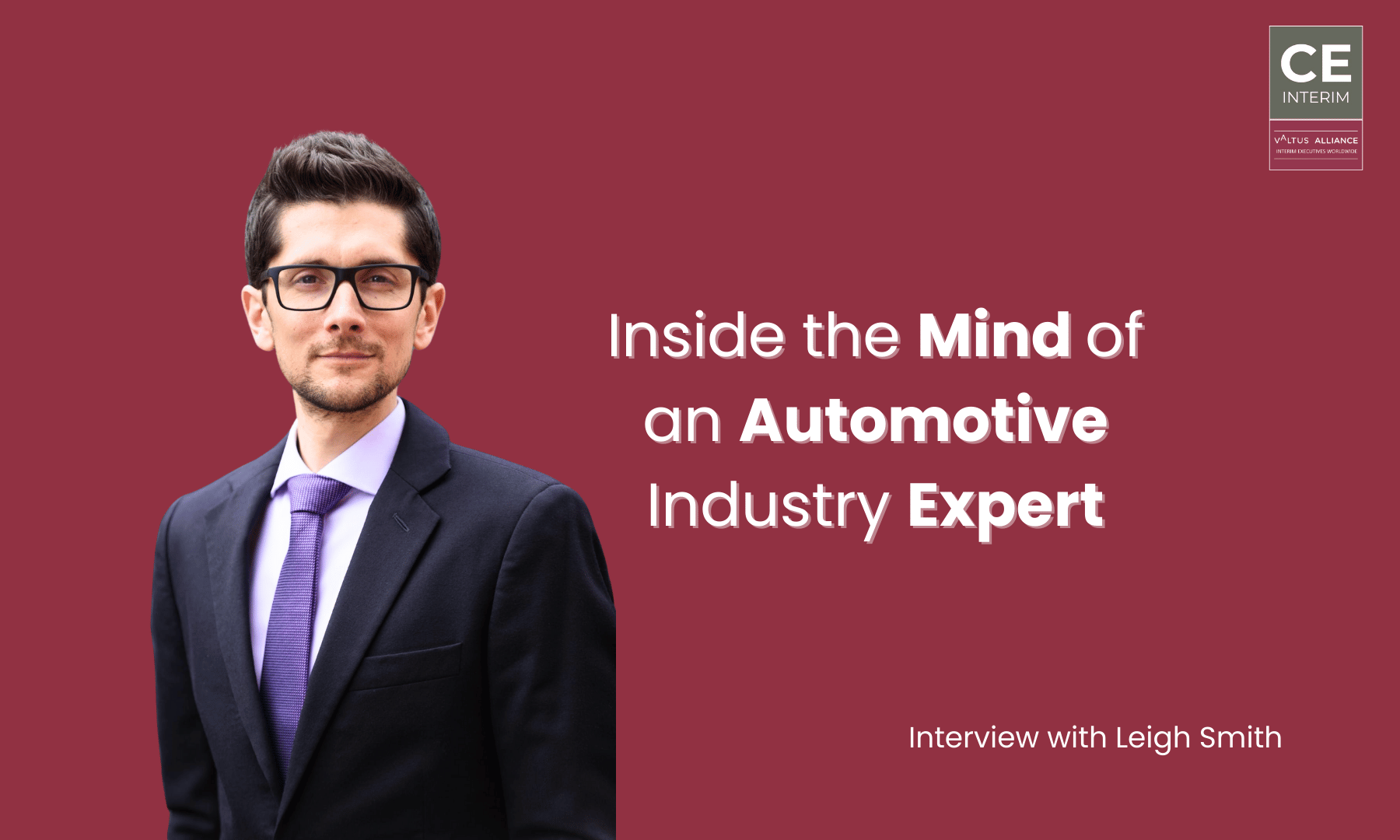Ebben az éleslátó beszélgetésben, Marian Fabian, a CE Interim ügyvezető partnere, interjúk Leigh Smith, az autóipari ágazat tapasztalt vezetője. Az Egyesült Királyságban, Közép- és Kelet-Európában, valamint Kínában futó karrierje során Leigh megosztja tapasztalatait a nagyszabású autóipari bevezetési projektek irányításáról, a kihívások kezeléséről és az iparág folyamatos átalakulásában való eligazodásról.
1. Bevezetés: A Journey Through the Automotive Industry (Utazás az autóiparon keresztül)
Marian Fabian:
Leigh, örülök, hogy velünk van. Kezdené azzal, hogy mesélne egy kicsit az autóiparban szerzett tapasztalatairól?
Leigh Smith:
Köszönöm, Marian. Jó itt lenni. Pályafutásomat gépészmérnök és később beköltözött gyártástechnológia. Korai karrieremet a Edwards, most már ismert mint Atlas Copco, ahol félvezető berendezéseken dolgoztam az Egyesült Királyságban, Dél-Koreában és a Cseh Köztársaságban.
Aztán csatlakoztam Ricardo, egy technológiai tanácsadó cégnél, mielőtt a Jaguar Land Rover (JLR), ahol hét évet töltöttem. Kezdetben a programirányítás az Egyesült Királyságban, mielőtt átállt volna a Szlovákia hogy segítsen elindítani a új Defender. Az utolsó szerepem a Kína, az Egyesült Királyságban kifejlesztett termékek helyi piacra történő bevezetésének irányítása.
Idővel a járművek puszta indításától eljutottunk oda. kifejezetten a kínai piacra szánt autók tervezése. Most, én átmenetileg ideiglenes irányítás, hogy új kihívásoknak vessem alá a szakértelmemet.
2. Az autóipari bevezetések összetettsége
Marian:
Az Egyesült Királyságban, Európában és Kínában is dolgozott már. Tapasztalatai alapján hogyan jellemezné a nagyszabású autóipari bevezetési projektek nagyságrendjét és összetettségét?
Leigh:
Az autóipari indítások a legösszetettebb ipari folyamatok közé tartoznak. A hagyományos belső égésű motoros (ICE) jármű a következő elemekből áll 30,000 alkatrész, míg egy elektromos jármű (EV) ezt a számot körülbelül 10,000.
E csökkenés ellenére a bonyolultság továbbra is megmarad az új szoftverintegráció, autonóm vezetési technológiák és változó vásárlói preferenciák.
A sikeres autóipari bevezetéshez egyensúlyra van szükség a következők között mérnöki pontosság, az ellátási lánc koordinációja és a vevői elvárások. A piaci igényeket át kell alakítania mérhető mérnöki jellemzők, menedzselni globális beszállítók, és a gyártóüzemek új technológiákhoz való alkalmazkodásának biztosítása-mindezt a költségek és a minőség fenntartása mellett.
3. Közös kihívások az autóipari bevezetéseknél
Marian:
Melyek a leggyakoribb kihívások, amelyekkel az autógyártóknak a nagyszabású bevezetések során szembe kell nézniük?
Leigh:
Számos kihívás merül fel:
1. Siló gondolkodás - A különböző részlegek (mérnöki, marketing, pénzügyi, termelési) gyakran egymástól függetlenül dolgoznak. Hatékony funkciókon átívelő koordináció kulcsfontosságú.
2. Időnyomás - Az új járművek piacra dobásának hagyományos ötéves ciklusa egyre rövidül, és ez megköveteli gyorsabb fejlesztés és gyártás.
3. Kockázatkezelés - Az eredeti tervtől való eltérések olyan kockázatokat jelentenek, amelyeknek strukturált enyhítési stratégiák.
4. Kulturális különbségek - A globális csapatok a következők szerint működnek különböző vezetési stílusok és elvárások, erős kommunikációs hidak.
A JLR-nél egy olyan programon dolgoztam, ahol egy magas haszonkulcsú jármű a gyártás késedelmével szembesült, ami a következők közötti eltérésből adódott mérnöki változások és gyártási realitások. Az én feladatom az volt, hogy diagnosztizáljam és megoldjam ezeket a problémákat, biztosítva, hogy a járműveket további javítások nélkül lehessen szállítani - ezzel időt és pénzt takarítva meg.
4. Legjobb gyakorlatok a sikeres autóipari bevezetésekhez
Marian:
A legjobb gyakorlatokat különböző piacokon látta. Milyen stratégiák működnek jól Európában más régiókkal szemben?
Leigh:
A oldalon. Európa, hangsúlyozzuk strukturált kockázatkezelés. A JLR-nél dolgozó volt menedzserem jól fogalmazott:
"Minden eltérés az ütemtervtől kockázatot jelent. Ha ezt nem mérsékeljük, akkor kikerülünk az irányítás alól."
A oldalon. Kína, a döntéshozatal sokkal gyorsabb. Ha a vezetés eldönti az irányt, a végrehajtás megtörténik. azonnal, néha strukturált kockázatelemzés nélkül. Kínában az én feladatom az volt, hogy mindkét megközelítést ötvözzem - kombinálva strukturált európai folyamatok a címen Kína gyors ütemű végrehajtási stílusa.
5. Az ideiglenes menedzserek szerepe az autóiparban
Marian:
Hogyan lehet egy ideiglenes vezető jelentős hatást gyakorol egy autóipari projektben?
Leigh:
Ideiglenes vezetőként az a célom, hogy energiát, friss perspektívákat és speciális szaktudást biztosítanak egy projektbe.
Egyszer például egy problémás jármű program ahol a gyártás a magas árrésű modellekkel küzdött. Azáltal, hogy Hat Szigma módszertanok, a feltételezések megkérdőjelezése és a új problémamegoldó technikák, egy "megépíthetetlen" járművet alakítottunk át egy jövedelmező termelési modell.
A kulcs az, hogy gyorsan a problémák diagnosztizálása, a csapatok közötti összhang megteremtése és a célzott beavatkozások végrehajtása.
6. Az autóipari bevezetések jövőjét alakító trendek
Marian:
Hogyan fejlődnek az autóipari bevezetési projektek az iparági trendekkel együtt?
Leigh:
Az iparágban jelenleg történelmi átalakulás:
- Villamosítás egyszerűsíti a járműarchitektúrákat, de a komplexitást a akkumulátor-technológia és szoftverintegráció.
- Autonóm és hálózatba kapcsolt járművek új készségeket igényelnek, keverednek autóipari, műszaki és üzleti szakértelem.
- Kína szerepe bővül - A "Kína Kínáért" helyett a "Kína a világért" elnevezésű kezdeményezés azt jelenti, hogy A kínai üzemek piacra dobása amelyek világszerte szabványokat állítanak fel.
Az OEM-eknek szükségük van agilis vezetők akik megtörni a hagyományos folyamatokat és alkalmazkodni ezekhez a változásokhoz.
7. Tanácsok az autóipari vezetőknek
Marian:
Mit tanácsolna a nagyszabású autóipari bevezetésekre készülő vezetőknek?
Leigh:
A tanácsom egyszerű: Vegyen fel olyan embereket, akik értik a jelenlegi folyamatokat - de bátorítsa őket, hogy szakítsanak velük.
Az autógyártóknak el kell fogadniuk a változás mint állandó. Azok lesznek sikeresek, akik egyensúlyt teremteni a strukturált végrehajtás és a rugalmasság között.
8. Gyors betekintés: Lightning Round
Marian:
Zárjuk le néhány gyors kérdéssel:
- A legnagyobb hiba a nagyszabású bevezetéseknél?
A silóba zárt gondolkodás erősítése ahelyett, hogy elősegítené a funkcionalitáson átívelő együttműködést. - Gördülékeny globális együttműködés biztosítása?
Olyan vezetők alkalmazása, akik képesek áthidalni a kulturális és nyelvi különbségeket. - A leginnovatívabb bevezetési stratégia?
A gyártási készültség mérése az alfa szakaszban, ahelyett, hogy a gyártásra várna. - A villamosítás hatása?
Gyorsabb indítások, nagyobb szoftverfüggőség és új minőségi referenciaértékek. - A legnagyobb tanulság a korábbi projektekből?
Az adatfegyelem kulcsfontosságú - a rossz adatok elvesztegetett időhöz és rossz döntésekhez vezetnek. - A digitális átalakulás szerepe?
Meglátásokat kell nyújtania, nem csak adatokat - ellenkező esetben nem hatékony. - A legjobb eszköz a komplexitás kezelésére?
Személyes termelékenységi rendszerek, mint például a "Getting Things Done" a hatalmas információáramlás kezelésére.
Végső gondolatok
Marian:
Köszönöm, Leigh, ezt az izgalmas beszélgetést. Az autóipari bevezetésekkel, a kulturális különbségekkel és a jövőbeli trendekkel kapcsolatos meglátásai felbecsülhetetlen értékűek.
Leigh:
Köszönöm, Marian. Nagyon élveztem ezt a beszélgetést, és várom, hogy lássam, hogyan fejlődik az iparág.
Marian:
Reméljük, hogy hamarosan újra beszélhetünk, miközben új kihívások elé nézel a ideiglenes vezetés!





